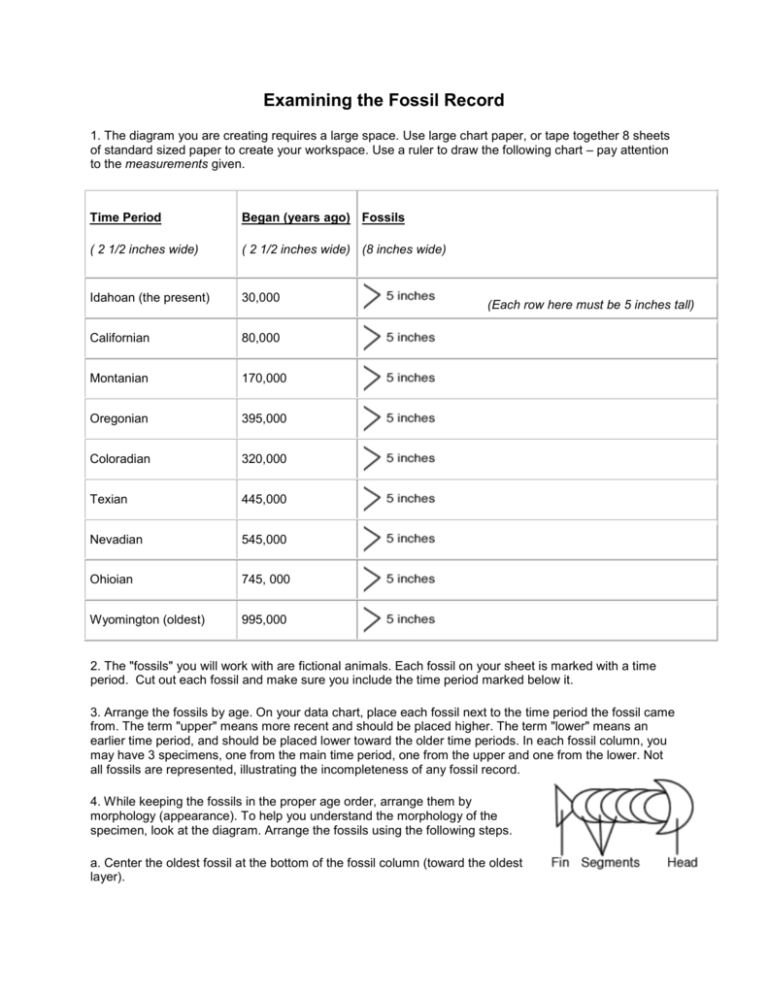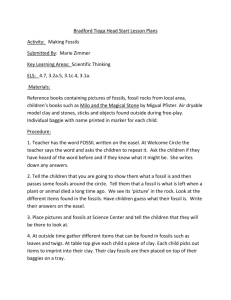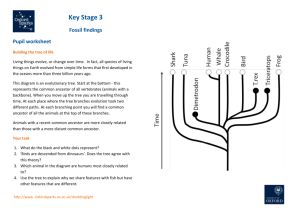Lesson 1 - The Fossil Record - Activity
advertisement

Examining the Fossil Record 1. The diagram you are creating requires a large space. Use large chart paper, or tape together 8 sheets of standard sized paper to create your workspace. Use a ruler to draw the following chart – pay attention to the measurements given. Time Period Began (years ago) Fossils ( 2 1/2 inches wide) ( 2 1/2 inches wide) (8 inches wide) Idahoan (the present) 30,000 Californian 80,000 Montanian 170,000 Oregonian 395,000 Coloradian 320,000 Texian 445,000 Nevadian 545,000 Ohioian 745, 000 Wyomington (oldest) 995,000 (Each row here must be 5 inches tall) 2. The "fossils" you will work with are fictional animals. Each fossil on your sheet is marked with a time period. Cut out each fossil and make sure you include the time period marked below it. 3. Arrange the fossils by age. On your data chart, place each fossil next to the time period the fossil came from. The term "upper" means more recent and should be placed higher. The term "lower" means an earlier time period, and should be placed lower toward the older time periods. In each fossil column, you may have 3 specimens, one from the main time period, one from the upper and one from the lower. Not all fossils are represented, illustrating the incompleteness of any fossil record. 4. While keeping the fossils in the proper age order, arrange them by morphology (appearance). To help you understand the morphology of the specimen, look at the diagram. Arrange the fossils using the following steps. a. Center the oldest fossil at the bottom of the fossil column (toward the oldest layer). b. Throughout the chart, those fossils that appear to be the same (or close to the same) as the fossils before (below) them should be placed in a vertical line c. During a certain period, the fossils will split into two branches. In other words, one fossil from that period will show one type of change, and another fossil will show a different change. When this happens, place the fossils side by side in the appropriate time period. From this point on you will have two lineages. 5. Once all the fossils have been placed correctly according to time and morphology, tape or glue the fossils in place. Analysis 1. Write a brief description of the evolutionary changes that occurred in the organism over time, from the oldest time period to the most recent. 2. During which time period did the fossils differentiate into two branches? Describe the change that occurred. 3. Define the following terms: morphology – fossil – phylogenetic tree – 4. Examine this fossil that was unearthered in a museum. The labels and other information were lost. Using your fossil record, determine which time period this fossil is likely from. Explain your answer. 5. Of the two major species that arose from the parent (original, earliest) species, which was more successful (best able to survive)? How do you know? 6. For each of the "blanks" on your fossil record make a sketch of what the animal would look like. Draw these directly on your fossil record on your chart paper. Fossils






